![]()
![]()
![]()
Use LEFT and RIGHT arrow keys to navigate between flashcards;
Use UP and DOWN arrow keys to flip the card;
H to show hint;
A reads text to speech;
79 Cards in this Set
- Front
- Back
|
Parietal Pericardium |
The membrane lining the pericardial cavity |
|
|
Pericardial sac |
Composed of fibrous tissue A sac that encloses the heart and its roots roots |
|
|
Visceral Pericardium |
Aka epicardium Tightly attached to surface of the heart Blue on APR |
|
|
Myocardium |
Muscle of the heart |
|
|
Endocardium |
Inner most membrane of heart Must be looking inside of heart to see |
|
|
Auricles |
Extensions of the atria |
|
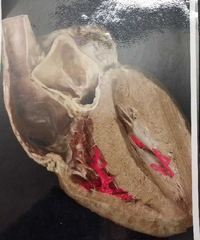
|
Trabeculae carneae |
|
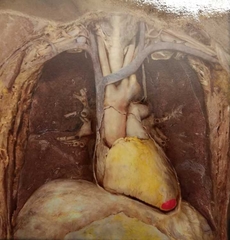
|
Apex |
|
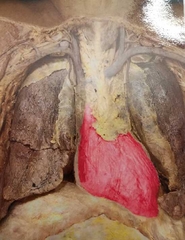
|
Parietal pericardium |
|

|
Fossa ovalis |
|
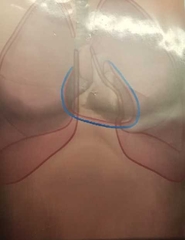
|
Parietal pericardium |
|
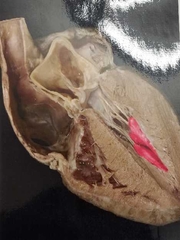
|
Papillary muscle |
|
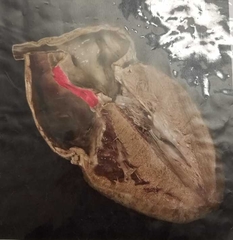
|
Interatrial septum |
|
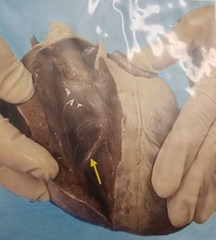
|
Moderator band |
|

|
Visceral pericardium |
|

|
Auricles |
|
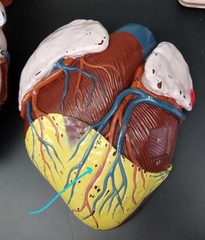
|
Adipose tissue |
|
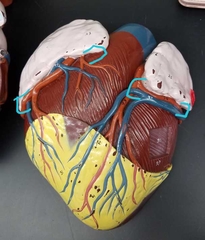
|
Atrioventricular groove Aka coronary sulcus |
|

|
Anterior interventricular groove |
|

|
Apex |
|
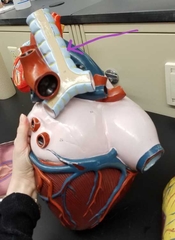
|
Trachea |
|
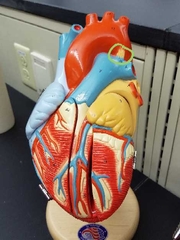
|
Ligament Arteriosum |
|

|
Coronary arteries |
|
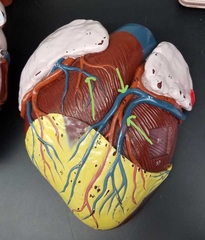
|
Coronary veins |
|

|
Base |
|
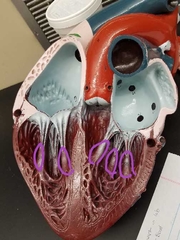
|
Papillary muscle |
|
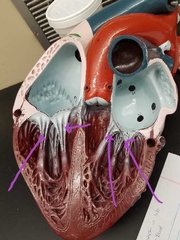
|
Chordae tendinae |
|

|
Trabeculae carneae |
|

|
Interventricular septum |
|
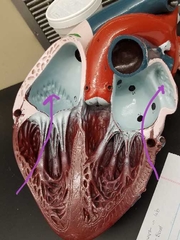
|
Pectinate muscle |
|
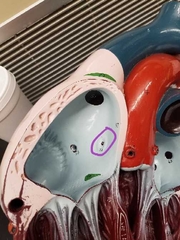
|
Fossa ovalis |
|

|
Interatrial septum |
|
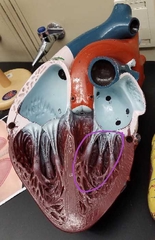
|
Left ventricle |
|
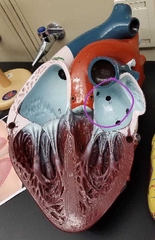
|
Left atrium |
|
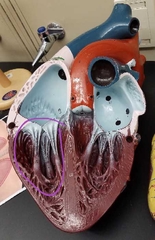
|
Right ventricle |
|

|
Right atrium |
|

|
Openings to coronary arteries |
|
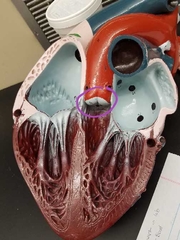
|
Aortic semilunar valve |
|
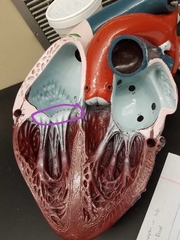
|
Right AV valve Aka Tricuspid valve |
|

|
Right pulmonary vein |
|

|
Left pulmonary vein |
|

|
Left pulmonary artery |
|
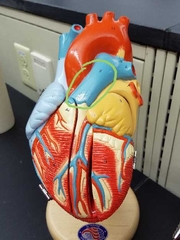
|
Pulmonary trunk |
|

|
Pulmonary semilunar valve |
|
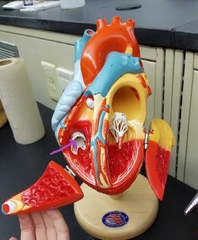
|
Right AV Valve Tricuspid valve |
|
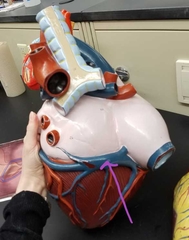
|
Coronary sinus |
|

|
Inferior vena cava |
|
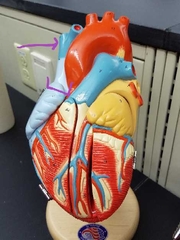
|
Superior vena cava |
|
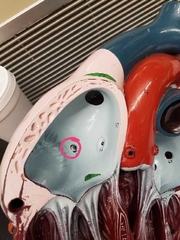
|
Opening to coronary sinus |
|
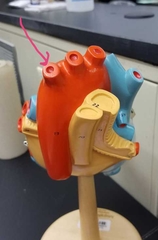
|
Left subclavian artery |
|
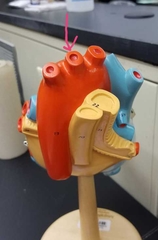
|
Left common carotid artery |
|
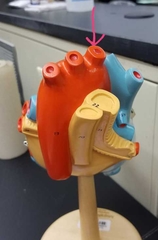
|
Brachiocephalic artery |
|

|
Descending aorta |
|
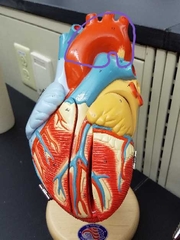
|
Aortic arch |
|
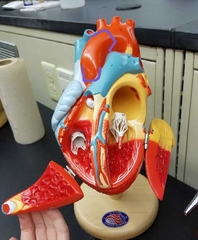
|
Ascending aorta |
|

|
Left AV Valve Bicuspid Valve Mitral valve |
|
|
Thoracic aorta |
Superior to the diaphragm |
|
|
Abdominal aorta |
Inferior to the diaphragm |
|
|
Describe the path an impulse takes within the conduction system of the heart |
1. Sinoatrial (SA) Node 2. Atrioventricular (AV) Node 3. Ateioventricular (AV) Bundle (Bundle of His) 4. R + L AV bundle branches 5. Purkinje fibers |
|
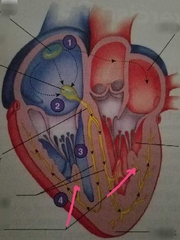
|
Purkinje fibers |
|
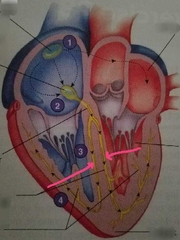
|
R+L AV Bundle Fibers |
|
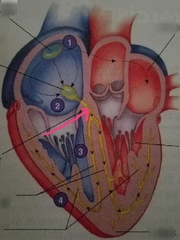
|
Bundle of His Aka Atrioventricular bundle |
|

|
Atrioventricular Node |
|
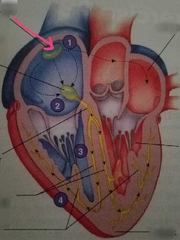
|
Sinoatrial Node Aka Pacemaker |
|

|
Atrioventricular Node |
|
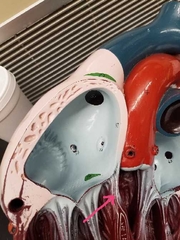
|
Bundle of His Atrioventricular Bundle |
|
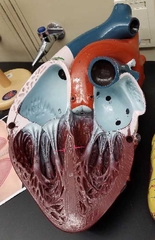
|
Left and right Atrioventricular Bundle branches |
|

|
Purkinje fibers |
|
|
List the structures blood passes through as it moves through the pulmonary circuit |
1. Right ventricle 2. Pulmonary trunk 3. Pulmonary arteries 4. Lungs 5. Pulmonary veins 6. Left atrium |
|
|
List the structures blood passes through as it moves through the systemic circuit |
1. Left ventricle 2. Ascending aorta 3. Aorta 4. Arteries 5. Capillaries 6. Veins 7. Coronary sinus 8. Right atrium |
|
|
What is the complete flow of blood through all structures? |
Deoxygenated 1. Superior Vena Cava, Inferior Vena Cava, Coronary Sinus 2. Right Atrium 3. Tricuspid Valve 4. Right Ventricle 5. Pulmonary Semilunar Valve 6. Pulmonary Trunk 7. Pulmonary Arteries 8. Lungs (now oxygenated) 9. Pulmonary Veins 10. Left Atrium 11. Bicuspid Valve 12. Left Ventricle 13. Aortic Semilunar Valve 14. Ascending Aorta 15. Aorta 16. Arteries 17. Capillaries (now deoxygenated) 18. Veins 19. Superior Vena Cava, Inferior Vena Cava, Coronary Sinus Etc... |
|
|
Serous Membrane |
Produce a serous fluid to reduce friction |
|
|
Layers of the heart from superficial to deep |
1. Pericardial sac 2. Parietal (serous) pericardium 3. Pericardial cavity 4. Visceral (serous) pericardium 5. Myocardium 6. Endocardium |
|
|
Pericardial cavity |
Contains serious fluid |
|
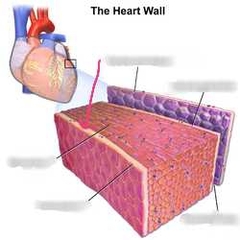
|
Endocardium |
|
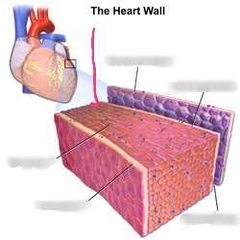
|
Myocardium |
|
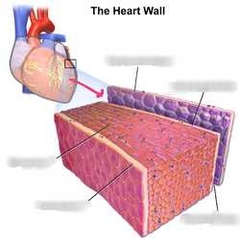
|
Pericardial cavity |
|
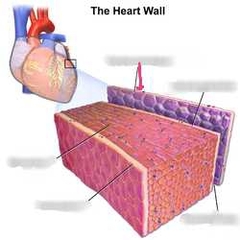
|
Parietal pericardium |
|
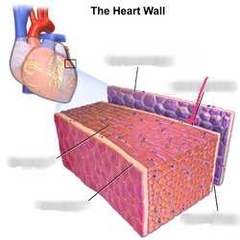
|
Visceral pericardium |

